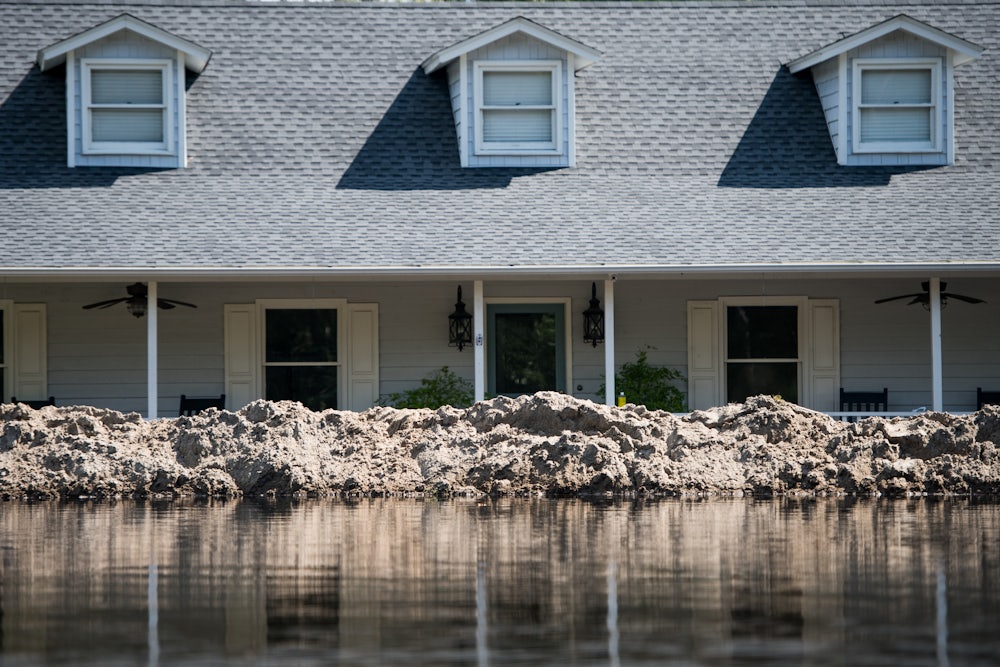Hurricane season is creeping its way deeper into spring. Last month, The Washington Post reported that the National Oceanic and Atmospheric Administration is considering officially moving up the start of the storm season from June 1 to May 15. The move, being reviewed by the NOAA’s National Hurricane Office in Miami, is the result of experts coming to the conclusion that, as global temperatures have consistently risen, so too have the frequency of pre-June storms.
According to the Post, the past six years have featured tropical storms forming before the official season start date, with last year’s Tropical Storm Arthur announced by the NOAA on May 16. By season’s end in December, 2020 ranked as the most active hurricane season in 15 years with 30 storms topping the 28-storm mark set by 2005.
How to measure hurricane season, however, isn’t as tricky as the other question global warming is already raising in coastal communities: how to prepare for it. A longer, more vicious hurricane season is just one part of the broader issue facing states, cities, and low-lying communities along the East Coast and the Gulf of Mexico that have already experienced what the threat of rising waters and accompanying storms will mean for their continued existence.
In Louisiana, the state and the U.S. Army Corps of Engineers—which enters with a substellar reputation, to say the least, given its colossal Katrina failures—are currently pursuing a $2 billion shoreline restoration project, known as the Mid-Barataria Sediment Diversion.* Initiated four years ago, the plan is designed to create roughly 28 square miles of marshes in the Barataria Basin, which has been eroding for years now.
The idea, according to NOLA.com, is to create a hole in the Mississippi River levee by the lower Plaquemines Parish and channel sediment-heavy river water into the West Bank wetlands. Rebuilding the marshes would mean future storm surges in the nearby West Bank communities would drop by a full foot. The plan, which recently cleared its environmental review, is not without its drawbacks—the manmade marsh would significantly impact the habitats currently relied on by the river’s bottlenose dolphins, oysters, and shrimp, as well as the local fishing-based economies that depend on them. But the Army Corps declared that the sacrifices were ultimately worth the exchange for reducing the storm surge and replenishing the marshes.
In Miami, city planners and real estate agents have responded to the issue of rising sea levels by consistently reassuring the city’s residents that Miami-Dade County has the resources and wherewithal to weather the projected two-foot hike. In a recently released plan, county officials acknowledged in the executive summary that “the more we invest in the short-term, the much smaller the costs will be in the long-term.”
But, as The New York Times noted in its coverage of the plan, the authors appeared to understate the potential breadth of the issue, which, by 2070, is expected to cost the community some $23.5 billion in lost property due to daily tidal flooding. The county’s solution centers mostly on densely populating the inland areas, putting new homes on stilts, and trucking in dirt and rocks to complete a process known as “fill,” wherein one manually raises existing buildings and roads. Even more pressing than what happens to the multimillion-dollar homes and condos along the shoreline is the fact that the areas most vulnerable to increased flooding and rougher storms are overwhelmingly home to marginalized, low-income communities. Still, the head of Miami-Dade’s climate adaption policy, pointing at the high cost of relocation, relayed to the Times that the more sensible solution is to “try to keep those areas livable.”
A similar situation is playing out in eastern North Carolina, an area that is home to the Lumbee Tribe—the largest Native community in the South—as well as a number of Black and Latinx communities. In the past few years, storms like Hurricane Matthew in 2016 and Hurricane Dorian in 2019 have led to massive floods across the region. During Dorian, over 400,000 people were evacuated from eastern North Carolina, with another 830,000 evacuated in South Carolina. Meanwhile, Matthew left large swaths of Lumberton, one of the Lumbee-majority towns, underwater, with calls from the tribe and neighboring communities for emergency funding lingering for years largely unanswered.
Last June, North Carolina Governor Roy Cooper released the Climate Risk Assessment and Resilience Plan, a 372-page report that attempts to meld “resiliency and climate change mitigation,” per Coastal Review. The idea is to provide a blueprint for the state’s transition to renewable energy while establishing a long-term plan to expedite the transfer of federal and state funds to local and tribal governments in need of immediate emergency responses. Cassie Gavin, the director of government affairs with the North Carolina Sierra Club, told the Review, “The plan is a good start in that it sets a path for state agencies and local governments to follow and lays out resiliency priorities that the legislature should fund.” The only issue: The North Carolina General Assembly remains in Republican control, as it has for the past decade, with the conservative legislators actively preventing any significant climate-focused policy from being passed.
Beyond the roadblock of partisanship, the elephant standing behind all of these well-meaning plans is the fact that many of these local and federal government agencies—from North Carolina to Florida to Louisiana—are still hooked into the nation’s existing gas and oil–based energy infrastructure. Louisiana’s attempts at shoreline restoration—again, a noble and necessary effort—are difficult to take seriously in the light of the state continuing to hand out tax breaks to the oil industry, further exacerbating its existing economic dependency and the effects of climate change. As NOLA pointed out, the entire reason that the marshes need to be rebuilt is because humans have spent the past century destroying them by building the levee systems and conducting nearby drilling. North Carolina’s power grid—as well as the power grid of its surrounding states—continues to be dominated by Duke Energy, which thus far has invested its resources in blocking a rapid transition to renewable energy and clinging to its monopoly, both in large part through political donations. Then consider where the funds are coming from for Louisiana’s shoreline project: Close to $8 billion in funding is being provided by BP to the state as restitution for the ongoing damages caused by the 2010 Deepwater Horizon oil spill.
The rising sea levels, the increased flooding, the bump in hurricane frequency—these can all be directly attributed to rising emissions caused in large part by the fossil fuel industry. Since roughly 1900, hurricane activity has been tied to the various stages of the Atlantic Multidecadal Oscillation, the climate system that experts have used to understand the pattern of hurricanes over the long term. The warm phase of the AMO typically lasts about 30 years and results in an uptick in both the number of storms per year and their strength. But in an article published last Friday in Science by Dr. Michael Mann—the individual responsible for naming the AMO in 2000—the climate scientist concluded that a combination of human-induced carbon emissions and preindustrial volcanic eruptions are actually to blame for our current uptick in hurricanes. This article is only the latest in a growing heap, over the past few years, constituting at this point a strong scientific consensus on the subject.
At this point, insufficient funds being put toward resilience strategies is only part of the problem. Any plans to deal with more severe weather and higher seas can feel like a form of climate denial if not paired with plans to get the surrounding areas off fossil fuels. Politics and the drive for short-term cash grabs will, as they have so far, continue to be the biggest impediment to American governments taking the obvious and necessary actions. If they win out over common sense and basic science, in a few decades, real estate agents in Miami will be pushing condos from the fourth floor and up, while the rest of us wonder why the hell nobody did anything about any of this.
*This article originally misstated the budget of the Mid-Barataria Sediment Diversion adaptation plan.








